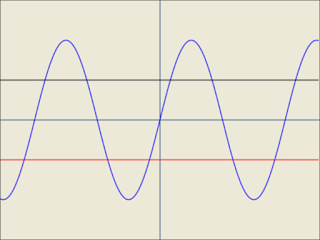Overdrive, distortion, fuzz, hard clipping, soft clipping... What gives?
When talking about distortion, I often hear questions about what difference there is between an overdrive, a fuzz, and a distortion, and what's different between soft and hard clipping. I'll attempt to briefly answer those questions in the post.
What's clipping?
"Clipping" is what happens to a signal when it is too powerful (or too hot) for a device. The type of clipping that is done depends on the circuit. In a effect pedal where an oversaturated signal is the intended end-result, makers will place certain diodes to clip the negative and positive parts of the waveform. The diodes don't have to be identical; you can use different diodes on both paths and-or combine many different diodes in series to shape the clipping to what you need. Designs using identical diodes are called symmetrical clipping circuits, and designs using different diodes are called (wait for it) asymmetrical clipping circuits.
Reference signal
The following graphs all use the following reference input signal:
Do the diodes matter?
Yes and no. Each type of diode has their own characteristics in terms of forward voltage they allow to go through. The position of the clipping circuit in the overall design has more to do with the type of clipping that will be achieved.
Schottky diodes have a very low forward voltage (0.15V) and will usually produce too much distortion and compression if used alone (they are usually used in pair, i.e. two on each path to soften their attack). Germanium and silicon usually range between 0.35V and 0.6V. LEDs (which are also diodes and can be used to clip your signal) will vary depending on the color. ProCo's TurboRat is well known for using 2 red LEDs as its clipping diodes. The following table lists some common LED and their forward voltage:
| Color | Forward voltage |
|---|---|
| Infrared | 1.2V |
| Red | 1.7V |
| Orange | 2.0V |
| Yellow | 2.1V |
| Green | 2.2V |
| Blue | 3.2V |
| White | 3.3V |
| Pink | 3.3V |
| Purple | 3.3V |
| Aqua | 3.4V |
| Ultraviolet | 3.8V |
Soft clipping
When the sound is soft clipped, the peaks of the waveform are rounded off when the clipping occurs. This give a softer sound, similar to a tube amp natural overdrive. The crude Paint.Net modifications on the graph below shows the top and bottom part are rounded off when being clipped by the diodes:
Soft clipping is achieved using a feedback loop on, say, an op amp which means that not all your signal is clipped all the time. Here is a very simplified clipping circuit:
Hard clipping
In a hard clipping circuit, the waveform is summarily and brutally cut when your signal goes through it. It's a very easy and effective way to distort signal, and it produces a much harsher sound. You can see in the following graph the clipped waveform looks a lot cruder than a soft clipped signal:
Hard clipping circuits are placed after the amplification stages so all the signal is clipped. The pair(s) of diodes are shunted to ground to make sure all these pesky waveform peaks disappear for good. Here's another very simplified circuit:
Overdrive
When instrument amplification became popular, solid state wasn't a thing just yet. At this point in time, we are most likely somewhere in 1930's and everything used vacuum tubes, the ancestor to the silicon transistor. Some tech-savyy musicians discovered that if you run the tubes hotter, you can get some nice gritty tones out of your amp. By "running hotter", I mean it literally. Vacuum tubes needs to heat up to a certain temperature before being operational, usually with the help a heater element within the tube. If you change the bias resistor to allow more voltage to go through, the tube will "overdrive" depending on the gain and volume settings on the amp, i.e. running hotter and causing the signal to distort.
Most overdrives are made to recreate how an overdriven tube amp would sound. The output of overdrive pedals are volume-dependent. For a same amount of gain, you'll get warm overtones at low volume, but harsh distortion at high volume. Of course, the type of clipping it uses makes a difference. Ibanez TS808 uses soft clipping, while the Klon Centaur uses hard clipping. Both sound great, but most overdrives use soft clipping.
Tip: use an overdrive pedal as a boost by keeping the gain at 0 and the volume maxed out. Works great on TubeScreamer-like circuits.
Distortion
Distortion just want to break your signal. It will create the same amount of distortion at any volume. They typically have more amplification/boost stages than overdrives and will generate huge amount of internal distortion. Up to a point, it can sound like an overdriven amp, but it's usually made to sound a lot harsher. Distortion pedals are usually hard clipping circuits. The ProCo Rat2 is among my favorite distortion, and sounds surprisingly well on bass.
Fun fact: the MXR Distortion+ is more of an overdrive than a distortion, even if it can sound quite hard.
Fuzz
Fuzz pedals were not designed to sound like an overdriven amp. The kind of distortion it generates is a lot harsher and harder than distortion pedals. Where the overdrive and distortion pedals output waveforms still somewhat resemble sine waves, the distortion introduced by fuzzes is of the square wave variety. Early fuzz-boxes like the Tone Bender and the Fuzz Face used two transistors to generate square wave distortion. EHX's Big Muff Pi is a four-transistors design and later transitioned to op-amp. Op-amp sound slightly different than transistors, and they achieve the same goal. It's all a matter of taste.
Fuzz caveat
Fuzz pedals are usually more difficult to place on your pedalboard than any other pedals, particularly early fuzz circuits. Two- and three-transistors designs, like the Fuzz Face and Tone Bender will not sound great unless they are the first pedal in the signal chain. If there is a buffer before it, it will not work great either. The main reason for this is that these pedals are designed to work with a certain input impedance which is out of range when putting other pedals or a buffer in front. Four-transistors designs usually do not have this problem, since the extra gain stage present is most likely enough to compensate for the impedance mismatch.








Comments
Post a Comment